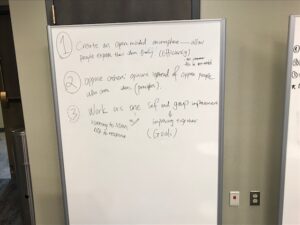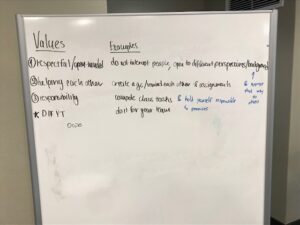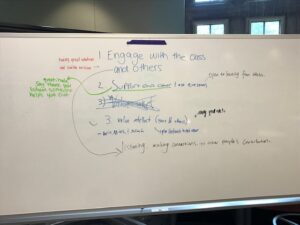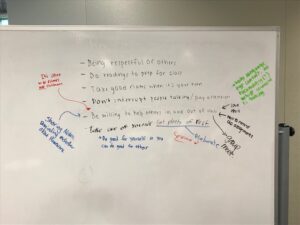Today, we started by looking at some of our Prep Notes. Note: the personal assignments and pieces that we create for the class won’t be posted on the blog.
Journaling and portfolio keeping both have elements of reflection (the writing itself is reflecting on an experience). By the time we look back at an experience, we can’t get back to what we thought before an experience. The best way to capture that feeling is to record it in the moment (recommends a self-check-in once a week to see how we’re feeling in the course).
As you are writing a draft for an assignment, do not just revise in the same document. Save the first draft as a separate document from the revised version!
We have two spaces to consider: the blog (our group space), and our personal space. “Artifacts” for the portfolio can come from both spaces. Everything we consider in our reflections must be accompanied by evidence (our own writing from either the blog or a personal folder).
For some people, the act of putting words to the page is the act of thinking, so just writing your thoughts down in your private space can be useful.
Reach out and support your peers – we’re here to learn from each other, and we can’t do that unless we’re all present and engaged.
Regarding the articles we read for today:
Memory is a spectrum of emotions, how people react to a situation (memories have context, feelings). The feeling of the article was more interpretive, less scientific. The author adds to the meaning of the writing (in this case, Britt Peterson). We can also see when the article was published (June 2014). It talks about other writings, so it’s more of an “article” instead of a “journal article.” The author is important to the piece, but so is the publisher. The publication is The Chronicle of Higher Education, and the word “chronicle” implies a record of something through time, or a timeline. Looking at the mission statement, and the humans behind the company, can help us understand why these people would want to publish the article (audience, purpose, etc.). The purpose of the publishers can often be tied to the the purpose of the article itself. Peterson’s goal was to make a starting point for faculty and students by giving an overview of some of Fivush’s and Bauer’s research. Both were psychologists, but it’s not necessarily written for other psychologists (more of a general audience).
Parents can have a real influence on which memories their children are developing (asking open-ended questions more than yes-or-no questions), but also how they learn to process memories. The stories they tell themselves become essential to their perception of their identities.
Children are not turnips in a car seat! They have opinions, they sing, they talk to their parents, etc.
Asked to think about our earliest memories – themes can be fear, or protection, but the memory has context. Can be very visual (i.e. the house surrounding us, the people in the space). Another element of memory: experiences that have been “put away” in a certain way. The difference between long-term and short-term memory is how quickly you can retrieve the experience.
How do memories get from short-term to long-term?
Firelight article: Deborah Netburn, 2014, the LA Times (what does it mean to be a news outlet today?). The journal article is by Polly Wiessner, an anthropology professor at the University of Utah, and her work was highlighted by an editorial board. Her work was based on conversations between tribespeople which she recorded at day and at night. The group of bushmen are among the last societies that are still primarily hunter-gatherers, so anthropologists use them to connect to old hunter-gatherer societies.
Firelight has a biological impact on people’s ability to tell stories. For instance, the lack of light takes away a barrier of worrying what others will think, because people’s faces can’t be seen as easily. Stories serve the function of connecting people across great distances (and even across time). It was a way to place themselves in other places, as well as communicate societal/cultural norms to their audiences. Telling stories around a fire allows people to pass down cultural knowledge to a new generation.
How might life be different if there was a story connected to every element of life, and those stories were shared every night with a group that you’re building your community with?




